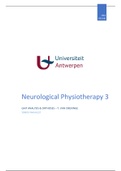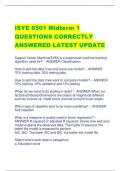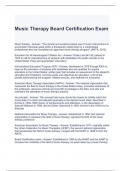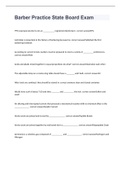1MA
REVAKI
Neurological Physiotherapy 3
GAIT ANALYSIS & ORTHOSES – T. VAN CRIEKINGE
YORICK VAN HULST
,Neurological Physiotherapy 3 1e master jaar Revaki UA
1 INHOUDSOPGAVE
2 Gait analysis in stroke patients .............................................................................................. 2
2.1 Gait and gait analysis in stroke ................................................................................................ 2
2.2 Changes in hemiparetic gait after stroke ................................................................................ 3
2.2.1 Problem identification ..................................................................................................... 4
2.2.2 Timing identification...................................................................................................... 10
2.3 Changes in hemiparetic gait after stroke assessed by instrumented gait analysis ............... 11
2.3.1 Spatiotemporal time parameters .................................................................................. 11
2.3.2 Kinematic and Kinetic .................................................................................................... 12
2.3.3 Muscle activity ............................................................................................................... 18
2.4 Implications for gait rehabilitation ........................................................................................ 19
3 HC2 – Orthoses & Assistive devices (part 1) ......................................................................... 20
3.1 Introduction ........................................................................................................................... 20
3.1.1 Definition ....................................................................................................................... 20
3.1.2 Classification .................................................................................................................. 20
3.2 Biomechanical principles ....................................................................................................... 20
3.2.1 Statics ............................................................................................................................ 20
3.2.2 Dynamics ....................................................................................................................... 22
3.3 Orthoses ................................................................................................................................ 23
3.3.1 Foot orthoses................................................................................................................. 23
3.3.2 Ankle Foot Orthoses ...................................................................................................... 25
3.3.3 Knee orthoses ................................................................................................................ 33
3.3.4 Hip orthoses .................................................................................................................. 34
4 HC3 – Orthoses & Assistive Devices (Part 2) ......................................................................... 36
4.1 Upper limb Orthoses ............................................................................................................. 36
4.1.1 Orthoses: upper limbs – finger, thumb and hand ......................................................... 37
4.1.2 Wrist hand orthosis (WHO) ........................................................................................... 38
4.1.3 Elbow wrist hand orthosis ............................................................................................. 41
4.1.4 Shoulder elbow orthosis (SEO) ...................................................................................... 41
4.2 General principles.................................................................................................................. 42
4.3 Assistive devices .................................................................................................................... 43
4.3.1 Assistive devices – canes, crutches, and walkers .......................................................... 43
1
,Neurological Physiotherapy 3 1e master jaar Revaki UA
2 GAIT ANALYSIS IN STROKE PATIENTS
2.1 GAIT AND GAIT ANALYSIS IN STROKE
Prerequisites for normal gait (Perry 1985)
- Prepositioning foot at IC
- Stability during stance
- Clearance in swing
- Adequate step length
- Energy conservation
De voorwaarden voor een normale gang. Als er iets mis is in deze voorwaarden, zal het gangpatroon
anders zijn.
Prepositioning voet met initial contact: tijdens IC maken we contact met de hak. Bijvoorbeeld bij
stroke/hemiplegic wordt dit soms gedaan met forefoot, door bijv. spastic voet. Dit veranderd je hele
gangpatroon.
Stability during stance: bijvoorbeeld bij hemiplegic patroon, zullen veel patiënten hyperextensie in de
knie krijgen. Is een teken van instabiliteit, passief staan op het been zonder actieve qceps. Dit hebben
we nodig voor een goede swing voor het been en genoeg balans tijdens lopen.
Clearance in swing: als er niet genoeg clearance in de swingfase is, is tripping/vallen wat je vaak ziet.
Dit zie je veel in hemiplegische patiënten. De extensiesynergie tijdens swing. Patiënten in hun
hemiplegisch been krijgen extensie in heup knie en voet. De voet wordt geslepen over de grond. Dit
is een grote oorzaak van vallen. Dit is dus een groot probleem in mensen met cva.
Adequate step length: je hebt propulsion nodig, je moet vooruit bewegen. je stappen moeten lang
genoeg zijn. Je rechtse stap gaat voor de linker voet en andersom. Niet naast het andere zetten.
Energy conservation: al deze tekenen/voorwaarden zijn belangrijk om genoeg energie te behouden.
Dat je gangpatroon niet te vermoeiend is. Patiënten moeten dit kunnen zonder moe te worden.
Hierdoor is lange afstanden beperkt. Ze hebben niet genoeg energy conservation. Is niet sufficiënt
genoeg om een gangpatroon te creëren dat normaal is en beperkend is in energieconsumptie. Als je
niet genoeg clearance in swing hebt, moet je een compensatie doen. Dit kost meer energie omdat
het een extra beweging is in een gangpatroon.
Gait in stroke (1)
Recovery depends on:
- Size & location of lesion
- Premorbid health
- 60-70% regains independent walking
Waarom is gait zo belangrijk. Het is het meest belangrijke doel na een cva.
2
,Neurological Physiotherapy 3 1e master jaar Revaki UA
role of instrumented gait analysis
- monitoring gait performance & functional recovery
- individual treatment goals
- evaluation of orthoses, walking aids, antispasticity treatment
Improvement of gait
- 2/3 of the patients cannot walk independently1
- Largest improvement in first 12 months2
- year: if independent walking (2/3): still slow & limited endurance
Improvement van gait kan door verschillende aspecten. Bijvoorbeeld AFO, fysiotherapie, operatie,…
2.2 CHANGES IN HEMIPARETIC GAIT AFTER STROKE
- Asymmetry
- Large variation of different gait patterns
- Increased energetic cost
- Primary, secondary and tertiary causes
We zien een sterke asymmetrie. Ook een grote variatie van verschillende gangpatronen.
3
,Neurological Physiotherapy 3 1e master jaar Revaki UA
2.2.1 Problem identification
Compensatie is niet het probleem. Je moet nagaan wat het probleem is achter de compensatie.
Compensatie is de oplossing, geen probleem. Pak dus nooit de compensatie aan, maar ga terug naar
de oorzaak en pak dat aan.
2.2.1.1 Primary problems
- Spasticity
- Muscle weakness
- Disturbed balance
- …
Primary causes → primary problems
Increased tone: kan van de adductor spieren, scissoring gait. Dit zie je niet veel in cva, maar veel in
diplegic zoals dwarslaesie. Je stiff knee gait zie je wel veel in cva. Ze zijn niet in staat om de knie te
buigen tijdens swing. Een andere is de equinovarus, te veel plantairflexie wat niet goed is voor IC,
maar ook swing niet, de clearance is dan niet genoeg.
Muscle weakness: trendelenburg, bij contralaterale drop door weakness in gluteii. Zwakte van qceps
is ook veel gezien in cva, dan zie je een knee extension thrust. Achterwaartse beweging tijdens stand.
Foot drop kan ook door zwakte tibialis anterior, in plaats van door increased tone van plantairflexie.
Disturbed automated reactions: trunk stiffness. We bewegen gekruisd in het lopen. In cva is deze
automatische reacties niet goed werken. Er is weinig trunkdissociatie etc.
4
, Neurological Physiotherapy 3 1e master jaar Revaki UA
Tone Muscle weakness Disturbed automated
reactions
Hip Adductor spasticity: Gluteus medius:
Scissoring gait Trendelenburg gait
*zie je niet veel bij cva,
maar kan wel.
*Trendelenburg gait
gebeurt wanneer tijdens
stand van standbeen, is er
zwakte gluteus medius, dus
contralaterale pelvic drop.
Normaal moet de pelvic
line horizontaal blijven.
Knee Rectus femoris spasticity: Quadriceps:
Stiff knee gait Knee extension thrust,
hyperextension or knee
buckling
*dit is misschien wel de
belangrijkste bij cva. Rectus *wat je wel veel ziet is
femoris spasticiteit. zwakte qceps, wat leidt tot
Normaal is je rectus femoris knee extension thrust. Wat
een spier dat de swingfase je hier ziet, is dat er te veel
initieert. Als deze spier te extensie is tijdens stand.
lang actief blijft, gaat het Genu recurvatum. De
ook tijdens knie extensie beweging richting extensie
initieren. Dat willen we niet gebeurt heel snel. Er is een
tijdens swingfase, we willen snelle achterwaardse
normale knieflexie. De beweging van knie, wat
grijze lijn is wat je normaal een knee extension thrust
ziet. In het begin zie je bijna betekent.
extensie knie, dan gaat Bij het dragen van gewicht
curve omhoog meer flexie, moet je knie in smalle
dan ben je bij loading knieflexie kunnen blijven
response met bearing door quadriceps. Als je
weight. Knie moet schokken qceps te zwak zijn, kan die
opvangen van IC. Dan ga je dit niet. Je kan dus door je
in standfase, dan zie je knie vallen, maar wat ook
extensie knie weer. Er is kan is volledig je knie naar
meer extensie, maar er is extensie gaat, passief. Je
altijd iets vaan flexie. Het qceps werken nu niet, dus
gaat nooit door de 0 graden passief. Daardoor kan hij
naar extensie. Dan gaat de zijn gewicht behouden.
swingfase, en komt er veel Dan zie je vaak
knie flexie, dus grote hyperextensie. Kan leiden
stijging curve. Dat is een
5
REVAKI
Neurological Physiotherapy 3
GAIT ANALYSIS & ORTHOSES – T. VAN CRIEKINGE
YORICK VAN HULST
,Neurological Physiotherapy 3 1e master jaar Revaki UA
1 INHOUDSOPGAVE
2 Gait analysis in stroke patients .............................................................................................. 2
2.1 Gait and gait analysis in stroke ................................................................................................ 2
2.2 Changes in hemiparetic gait after stroke ................................................................................ 3
2.2.1 Problem identification ..................................................................................................... 4
2.2.2 Timing identification...................................................................................................... 10
2.3 Changes in hemiparetic gait after stroke assessed by instrumented gait analysis ............... 11
2.3.1 Spatiotemporal time parameters .................................................................................. 11
2.3.2 Kinematic and Kinetic .................................................................................................... 12
2.3.3 Muscle activity ............................................................................................................... 18
2.4 Implications for gait rehabilitation ........................................................................................ 19
3 HC2 – Orthoses & Assistive devices (part 1) ......................................................................... 20
3.1 Introduction ........................................................................................................................... 20
3.1.1 Definition ....................................................................................................................... 20
3.1.2 Classification .................................................................................................................. 20
3.2 Biomechanical principles ....................................................................................................... 20
3.2.1 Statics ............................................................................................................................ 20
3.2.2 Dynamics ....................................................................................................................... 22
3.3 Orthoses ................................................................................................................................ 23
3.3.1 Foot orthoses................................................................................................................. 23
3.3.2 Ankle Foot Orthoses ...................................................................................................... 25
3.3.3 Knee orthoses ................................................................................................................ 33
3.3.4 Hip orthoses .................................................................................................................. 34
4 HC3 – Orthoses & Assistive Devices (Part 2) ......................................................................... 36
4.1 Upper limb Orthoses ............................................................................................................. 36
4.1.1 Orthoses: upper limbs – finger, thumb and hand ......................................................... 37
4.1.2 Wrist hand orthosis (WHO) ........................................................................................... 38
4.1.3 Elbow wrist hand orthosis ............................................................................................. 41
4.1.4 Shoulder elbow orthosis (SEO) ...................................................................................... 41
4.2 General principles.................................................................................................................. 42
4.3 Assistive devices .................................................................................................................... 43
4.3.1 Assistive devices – canes, crutches, and walkers .......................................................... 43
1
,Neurological Physiotherapy 3 1e master jaar Revaki UA
2 GAIT ANALYSIS IN STROKE PATIENTS
2.1 GAIT AND GAIT ANALYSIS IN STROKE
Prerequisites for normal gait (Perry 1985)
- Prepositioning foot at IC
- Stability during stance
- Clearance in swing
- Adequate step length
- Energy conservation
De voorwaarden voor een normale gang. Als er iets mis is in deze voorwaarden, zal het gangpatroon
anders zijn.
Prepositioning voet met initial contact: tijdens IC maken we contact met de hak. Bijvoorbeeld bij
stroke/hemiplegic wordt dit soms gedaan met forefoot, door bijv. spastic voet. Dit veranderd je hele
gangpatroon.
Stability during stance: bijvoorbeeld bij hemiplegic patroon, zullen veel patiënten hyperextensie in de
knie krijgen. Is een teken van instabiliteit, passief staan op het been zonder actieve qceps. Dit hebben
we nodig voor een goede swing voor het been en genoeg balans tijdens lopen.
Clearance in swing: als er niet genoeg clearance in de swingfase is, is tripping/vallen wat je vaak ziet.
Dit zie je veel in hemiplegische patiënten. De extensiesynergie tijdens swing. Patiënten in hun
hemiplegisch been krijgen extensie in heup knie en voet. De voet wordt geslepen over de grond. Dit
is een grote oorzaak van vallen. Dit is dus een groot probleem in mensen met cva.
Adequate step length: je hebt propulsion nodig, je moet vooruit bewegen. je stappen moeten lang
genoeg zijn. Je rechtse stap gaat voor de linker voet en andersom. Niet naast het andere zetten.
Energy conservation: al deze tekenen/voorwaarden zijn belangrijk om genoeg energie te behouden.
Dat je gangpatroon niet te vermoeiend is. Patiënten moeten dit kunnen zonder moe te worden.
Hierdoor is lange afstanden beperkt. Ze hebben niet genoeg energy conservation. Is niet sufficiënt
genoeg om een gangpatroon te creëren dat normaal is en beperkend is in energieconsumptie. Als je
niet genoeg clearance in swing hebt, moet je een compensatie doen. Dit kost meer energie omdat
het een extra beweging is in een gangpatroon.
Gait in stroke (1)
Recovery depends on:
- Size & location of lesion
- Premorbid health
- 60-70% regains independent walking
Waarom is gait zo belangrijk. Het is het meest belangrijke doel na een cva.
2
,Neurological Physiotherapy 3 1e master jaar Revaki UA
role of instrumented gait analysis
- monitoring gait performance & functional recovery
- individual treatment goals
- evaluation of orthoses, walking aids, antispasticity treatment
Improvement of gait
- 2/3 of the patients cannot walk independently1
- Largest improvement in first 12 months2
- year: if independent walking (2/3): still slow & limited endurance
Improvement van gait kan door verschillende aspecten. Bijvoorbeeld AFO, fysiotherapie, operatie,…
2.2 CHANGES IN HEMIPARETIC GAIT AFTER STROKE
- Asymmetry
- Large variation of different gait patterns
- Increased energetic cost
- Primary, secondary and tertiary causes
We zien een sterke asymmetrie. Ook een grote variatie van verschillende gangpatronen.
3
,Neurological Physiotherapy 3 1e master jaar Revaki UA
2.2.1 Problem identification
Compensatie is niet het probleem. Je moet nagaan wat het probleem is achter de compensatie.
Compensatie is de oplossing, geen probleem. Pak dus nooit de compensatie aan, maar ga terug naar
de oorzaak en pak dat aan.
2.2.1.1 Primary problems
- Spasticity
- Muscle weakness
- Disturbed balance
- …
Primary causes → primary problems
Increased tone: kan van de adductor spieren, scissoring gait. Dit zie je niet veel in cva, maar veel in
diplegic zoals dwarslaesie. Je stiff knee gait zie je wel veel in cva. Ze zijn niet in staat om de knie te
buigen tijdens swing. Een andere is de equinovarus, te veel plantairflexie wat niet goed is voor IC,
maar ook swing niet, de clearance is dan niet genoeg.
Muscle weakness: trendelenburg, bij contralaterale drop door weakness in gluteii. Zwakte van qceps
is ook veel gezien in cva, dan zie je een knee extension thrust. Achterwaartse beweging tijdens stand.
Foot drop kan ook door zwakte tibialis anterior, in plaats van door increased tone van plantairflexie.
Disturbed automated reactions: trunk stiffness. We bewegen gekruisd in het lopen. In cva is deze
automatische reacties niet goed werken. Er is weinig trunkdissociatie etc.
4
, Neurological Physiotherapy 3 1e master jaar Revaki UA
Tone Muscle weakness Disturbed automated
reactions
Hip Adductor spasticity: Gluteus medius:
Scissoring gait Trendelenburg gait
*zie je niet veel bij cva,
maar kan wel.
*Trendelenburg gait
gebeurt wanneer tijdens
stand van standbeen, is er
zwakte gluteus medius, dus
contralaterale pelvic drop.
Normaal moet de pelvic
line horizontaal blijven.
Knee Rectus femoris spasticity: Quadriceps:
Stiff knee gait Knee extension thrust,
hyperextension or knee
buckling
*dit is misschien wel de
belangrijkste bij cva. Rectus *wat je wel veel ziet is
femoris spasticiteit. zwakte qceps, wat leidt tot
Normaal is je rectus femoris knee extension thrust. Wat
een spier dat de swingfase je hier ziet, is dat er te veel
initieert. Als deze spier te extensie is tijdens stand.
lang actief blijft, gaat het Genu recurvatum. De
ook tijdens knie extensie beweging richting extensie
initieren. Dat willen we niet gebeurt heel snel. Er is een
tijdens swingfase, we willen snelle achterwaardse
normale knieflexie. De beweging van knie, wat
grijze lijn is wat je normaal een knee extension thrust
ziet. In het begin zie je bijna betekent.
extensie knie, dan gaat Bij het dragen van gewicht
curve omhoog meer flexie, moet je knie in smalle
dan ben je bij loading knieflexie kunnen blijven
response met bearing door quadriceps. Als je
weight. Knie moet schokken qceps te zwak zijn, kan die
opvangen van IC. Dan ga je dit niet. Je kan dus door je
in standfase, dan zie je knie vallen, maar wat ook
extensie knie weer. Er is kan is volledig je knie naar
meer extensie, maar er is extensie gaat, passief. Je
altijd iets vaan flexie. Het qceps werken nu niet, dus
gaat nooit door de 0 graden passief. Daardoor kan hij
naar extensie. Dan gaat de zijn gewicht behouden.
swingfase, en komt er veel Dan zie je vaak
knie flexie, dus grote hyperextensie. Kan leiden
stijging curve. Dat is een
5





